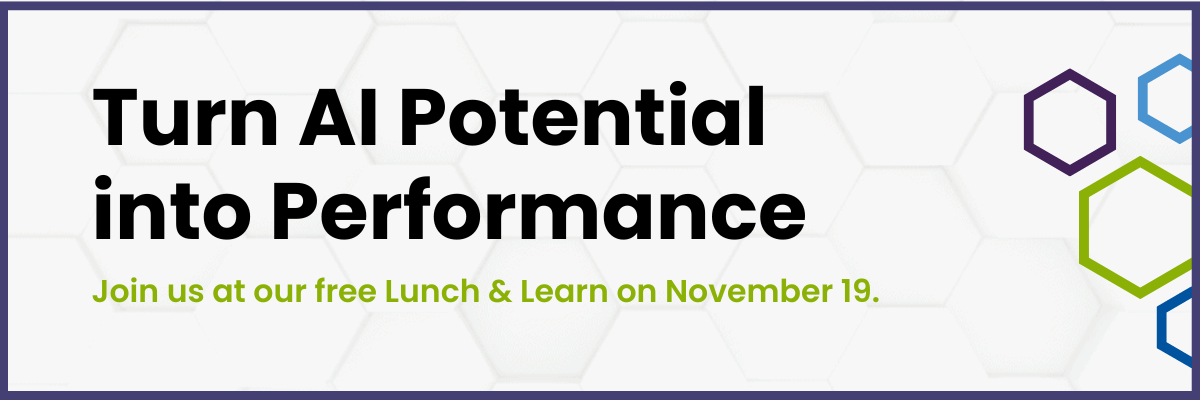Artificial intelligence (AI) is transforming the way industries work, but many organizations are still waiting for this AI gold rush to yield results. Despite billions invested, a recent MIT report found that 95% of AI projects fail to deliver on their promises.
Take the recent example of Deloitte Australia, which refunded part of the $290,000 they were paid to produce a report for the Australian government after it was found to contain apparent AI-generated errors, including fabricated quotes and references to non-existent sources and research papers (known as “hallucinations”).
This high-profile misstep highlights a growing issue: companies are racing to deploy AI without the strategy, governance, or data foundations to make it successful. Technology alone isn’t the answer; AI success requires alignment between business goals, reliable data, and a workforce ready to embrace change.
In this article – and at our upcoming AI Readiness Lunch & Learn Sessions on November 19, 2025 and January 22, 2026 – we’ll explore why most AI implementations fail and how your business can avoid the same mistakes to achieve lasting value from machine learning adoption.
Why So Many AI Projects Fail
For all its potential, AI success remains elusive for most businesses. The issue is less to do with the technology itself and more about how it’s implemented. Too many organizations approach AI as a quick fix or a trend to follow, rather than a long-term investment in their digital transformation strategy.
We’ve found that failed AI initiatives almost always share three common traits:
- Strategic Misalignment
Many businesses jump into AI adoption without defining clear business outcomes. When goals aren’t linked to measurable return on investment (ROI), like improving decision-making accuracy or reducing manual workloads, projects quickly lose direction and executive support. - Weak Foundations in Data and Governance
AI tools are only as effective as the data feeding them. Inconsistent, siloed, or poor-quality data undermines even the most advanced algorithms. Without solid AI governance to ensure accuracy, security, and accountability, insights become unreliable – or worse, misleading. - Human Resistance and Poor Change Management
Technology can’t succeed without people behind it. A lack of AI change management often means employees don’t trust or understand new systems, leading to low adoption and wasted investment. In a recent McKinsey report, 48% of surveyed employees ranked training as the most important factor for generative AI adoption, but almost half of that group don’t feel they’re receiving it.
These three pitfalls form the root of nearly all AI deployment challenges. Understanding them is the first step toward reversing the trend and building a foundation that actually delivers measurable value.
Strategic Pitfall #1: Chasing AI Without a Clear Business Purpose
One of the biggest reasons AI projects fail is that they start with the technology, not the problem. Many businesses feel pressured to “do something with AI” without identifying how it actually supports their business goals. This results in ambitious pilots that generate interest but ultimately have little long-term impact.
True AI success begins with strategy. Before deploying tools like Microsoft Copilot or other machine learning platforms, leaders need to ask:
- What specific business challenge are we trying to solve?
- How will success be measured?
- Which processes or departments will this improve?
AI should be a natural extension of your digital transformation strategy, not a standalone experiment. When aligned with real objectives – like improving customer service, accelerating reporting, or enabling data-driven decision-making – AI can deliver measurable ROI. But without that alignment, it quickly becomes a costly distraction.
Technical Pitfall #2: Bad Data and Weak Governance
Even the most advanced AI system is only as good as the data it’s built on. Without accurate, consistent, and well-governed data, organizations risk turning AI into a liability rather than an asset.
Poor data quality is one of the most common AI deployment challenges we see. Incomplete records, conflicting data sources, and outdated information all limit the accuracy of AI models, leading to poor predictions and unreliable insights. In the Deloitte Australia case, for example, weak oversight and a lack of AI governance allowed “hallucinated” content to make its way into a government report – an entirely avoidable failure with the right review processes in place.
Strong governance ensures accountability at every stage of AI implementation. This includes:
- Data integrity: Ensuring data is verified, consistent, and ethically sourced.
- Security and compliance: Protecting sensitive information as AI systems integrate across the business.
- Ongoing monitoring: Reviewing outputs regularly to identify bias or drift before they cause reputational or financial damage.
Before any AI initiative can succeed, organizations must first prepare their data and establish guardrails for how it’s used.
Human Pitfall #3: Neglecting AI Change Management
AI adoption isn’t just a technical project; it’s a people project too. Many initiatives fail not because the technology doesn’t work, but because teams don’t know how to use it, don’t trust it, or don’t see how it benefits their day-to-day work.
Effective AI change management is about helping employees understand and embrace what AI means for them. When leaders skip this step, resistance sets in. Staff may revert to old habits, bypass new systems, or interpret automation as a threat to their roles, all of which erode ROI and stall innovation.
Building buy-in starts with communication and training. Business leaders should:
- Explain the “why” – Make it clear how AI supports company goals and benefits individuals.
- Provide hands-on learning – Offer workshops or pilot programs where employees can see real improvements in efficiency.
- Celebrate small wins – Highlight success stories to reinforce progress and build momentum.
There’s an (understandable) assumption that AI is here to replace people, so it’s up to business leaders to make sure people know it’s really here to empower them. When teams feel supported and informed, they become advocates for change rather than barriers to it.
Avoiding the Same Mistakes: Building a Framework for Success
Successful implementations follow a deliberate framework that balances strategy, technology, and people. These principles lay the groundwork for sustainable success and will form a core part of the discussion at our upcoming AI Readiness Lunch & Learn, where we’ll explore how St. Louis businesses can turn theory into action and achieve measurable AI ROI.
- Assess Readiness
Before investing in any AI tool, evaluate your data, security, and infrastructure. A thorough readiness assessment can reveal gaps in governance, integration, and compliance that could derail future progress. This foundational step ensures your systems are ready to support reliable, scalable AI. - Align Strategy
Define what success looks like and make it measurable. Tie every AI initiative to specific business outcomes such as improved productivity, reduced manual processes, or better data-driven decision-making. This alignment keeps projects on track and makes it easier to prove AI ROI to stakeholders. - Adopt Thoughtfully
Start small, learn fast, and scale strategically. Pilot programs, feedback loops, and continuous training ensure that machine learning adoption evolves in step with your team’s confidence and capability. This adaptive approach transforms AI from an experiment into a long-term advantage.
For many organizations, knowing where to start is the hardest part. That’s exactly what we’ll be unpacking at our upcoming AI Readiness Lunch & Learn. It’s a practical, in-person session designed to help local business leaders apply these principles to their own digital transformation strategy. You’ll learn how to assess your current environment, align AI with your goals, and build a governance model that supports confident, sustainable adoption.
Attendees will also receive our AI Self-Assessment Checklist, which helps to identify where your organization stands today and what to prioritize next.
Turn AI Potential into Performance
The Deloitte Australia example is a clear reminder that even the biggest names can stumble when AI is deployed without the right guardrails. Success doesn’t come from adopting the latest tools; it comes from building a foundation of strategy, data integrity, and human alignment that makes those tools work for you.
AI can absolutely transform the way your business operates, but only if it’s implemented thoughtfully and governed responsibly. With the right preparation, clear objectives, and a culture that supports innovation, your organization can achieve measurable ROI and lasting value from its AI investments.
If you’re ready to move beyond the hype and see how to make AI work for your business, join us on either November 19, 2025 or January 22, 2026. Enjoy lunch, connect with local business leaders, and walk away with practical insights to help your organization avoid the common pitfalls of AI adoption. It’s completely complimentary, but space is limited, so reserve your seat today.



